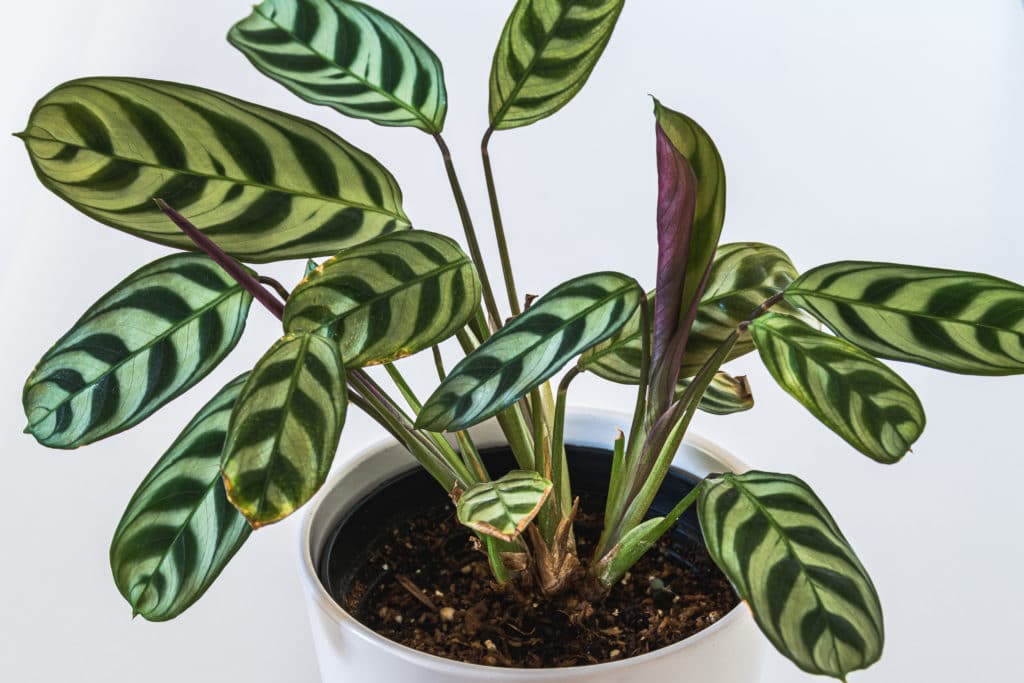
If you’re looking for a low-maintenance tropical plant to add some life to your home, the Ctenanthe (Never Never) plant is a great option. This evergreen plant is native to the rainforests of Brazil and has beautiful, variegated foliage that can brighten up any room. In this blog post, we will discuss the care requirements for the Ctenanthe plant so that you can keep it healthy and thriving!
Caring For A Ctenanthe Plant (Never Never Plant)
Keeping a Brazilian native plant in your house may seem difficult, but it is actually quite simple if you know what it requires to grow. The Ctenanthe plant, also known as the Never Never plant, is an evergreen perennial with variegated leaves that can bring life and color to any room.
What should I feed my Ctenanthe Plant? In well-draining soil, grow your plant without fail. Provide bright, indirect light and keep the dirt damp but not soggy if you want to maintain your never-never plant. Maintain a lot of humidity and temperatures between 55 and 85 degrees Fahrenheit throughout the growing season with a half-strength fertilizer once a month.
The Never Never plant, when properly cared for, adds a beautiful and one-of-a-kind touch to your house. Many homeowners and gardeners, on the other hand, are unaware of the most convenient growing conditions that will allow this plant to thrive. Continue reading to learn all you need to know about caring for your Ctenanthe Plant successfully.
Never Never Plant Information
The Ctenanthe Plant is a flowering plant in the Marantaceae family. These plants are evergreen perennials that are native to Brazil’s tropical rainforest regions, but they may also be found in certain areas of Central America, such as Costa Rica’s rainforest region. Due to their multicolored leaves, these plants are popular garden plants throughout their natural range and beyond.
Because they are from the tropics, they are extremely sensitive to frosts and can be badly damaged whenever outdoor temperatures drop below 55°F (13°C).
North American growers, on the other hand, generally cultivate Never Never plants in containers and bring them outside in late spring after the danger of frost has passed. They are then brought inside during the latter part of fall and winter.
What To Do With Your Never Never Plant
Even if you live in areas where the long and cold winter is a distant dream from the sun and heat of the rainforest, the Never Never plant’s silver-green striped leaves will bring a touch of the tropics to your home.
The Never Never Plant is recognized for its lance-shaped leaves with dark green foliage highlighted by silver stripes or bands. These silver bands have another name: the Brazilian Snow Plant, since they resemble the streaks on a snowfield. Despite their modest blossoms, most home gardeners prefer this plant for its spectacular form.
This tropical evergreen plant thrives in a culture that closely mimics the humidity, temperature, light levels, and soil of its natural tropical rainforest environment. The plant may grow without these conditions, although it will not have the distinctive foliage coloration that is sought after by plant enthusiasts all around the world.
- Origin: Central and South American rainforest areas
- Light Requirements: Bright, indirect illumination is best. Avoid direct sunshine to the greatest extent feasible.
- Watering: Water when the top of the soil feels dry, but don’t overwater. Water once the surface of the dirt has become dry.
- Soil: A nutrient-dense, well-draining potting mix. A combination of potting soil, peat, and perlite works wonders.
- Temperature: 55-85°F (13-29°C).
- Fertilizer: This method is used to fertilize plants as they are growing. It’s a monthly dose of balanced, water-soluble fertilizer.
- Humidity: Medium to high humidity. In very dry conditions, leaves curl and the tips become brown.
- Flowering: When grown in optimal circumstances, the tiny, inconspicuous white/yellow blooms appear at irregular intervals throughout the year.
- Pruning: Basically, pruning is a way to alter the shape of a plant. To restrict growth and remove dead foliage, all you have to do is control size and trim it. If left unchecked, the plant would spread out.
- Propagation: By division or seed.
- Re-Potting: Every 1-2 years in springtime
- Popular Varieties: C. burle-marxii, C. oppenheimiana, C. marantifolia.
- Diseases and Pests: Although botrytis can grow in excessively moist circumstances, it is not particularly resistant. In highly humid areas, botrytis thrives. Mealybugs, thrips, and spider mites may be present as well.
- Toxicity: It’s perfectly safe for children and pets.
Understanding the Ctenanthe Plant
The Never Never plant can reach a height of up to seven feet (about 2 meters) and a width of up to three feet (0.9 meters) when cultivated in the proper growing conditions, spreading horizontally rather than vertically. They have long oval leaves measuring up to 16 inches (40 centimeters) in length with distinctive silver markings.
The size of the plant will be determined by the size of the container and is adjusted for optimum root growth. Ctenanthe plants in small containers, on the other hand, may easily reach several feet in length.
In most situations, the undersides of the leaves will take on a dark maroon tone for added color and texture. Because of its small growth habits, little trimming is required, making this an easy-to-care-for home plant.
What Light Do I Need For My Never Never Plant?
One of the most crucial components of nurturing a Never Never plant is to provide it with bright, but indirect light. Consider the rainforest ecosystem in which these plants thrive while selecting where to put your Never Never plant. Long periods of sunshine are typical, although the thick forest canopy provides shading, lowering the amount of direct light received.
Incorrect lighting might contribute to foliage problems that will detract from the plant’s beauty. Without a consistent and constant source of indirect, yet bright light, the color patterns on the leaves will shift dramatically.
With too little light, the new growth will be solid, dark green in hue, and the beautiful silver designs will be either undetectable or entirely absent. Too much light, on the other hand, will cause fading to take place, dulling the splendor of the brilliant hues.
You can put your Ctenanthe plant in shaded windows. You don’t want the hot, direct sun from the south or west to strike your plant for extended periods of time.
In most cases, a Never Never plant should be placed in front of an east or north-facing window (if you live in the northern hemisphere).
Water Needs Of The Never Never Plant
As with all plants, proper watering is required for the plant to flourish. While Ctenanthe species plants are typically resilient to a variety of soil wetness levels, you should make careful not to let them dry out. After the top of the soil feels dry, give it a good dousing.
Fill the pot with water until it drains through the drainage holes. I usually water my little houseplants at the sink, allowing excess water to flow out of the pot before replacing them in their usual places. If you’re using a drip tray, be sure to empty it after a few minutes so as not to submerge your roots.
Plant root rot can be caused by continual overwatering. Rather than following a watering schedule, you should check the condition of the plant and the moistness of the potting soil to determine when water is necessary, rather than relying on a timetable.
Brown leaf tips can appear on Never plants if you irrigate with tap water that is high in chlorine or fluor. Filtered water, distilled water, or captured rainwater should be used as a first option.
Ctenanthe Plant Temperatures (Never, Never Plant)
Despite being native to the Amazon rainforest, the Never Never Plant will be able to endure and even flourish in colder conditions. If you reside in a place where the summers are not too hot, as long as temperatures do not drop below 55°F (13°C), your plant should be fine.
It adapts to typical indoor temperatures because it requires temperatures between 55 and 85 degrees Fahrenheit. Because the plant thrives in conditions between 55 and 85 degrees Fahrenheit, people who reside in locations where the weather is harsh should be careful not to expose it to hard frosts since one night of severe frost might ruin it completely.
Ctenanthe Plant Soil and Fertilizer (No Never Plant)
Although most potting soils will work well for your Never Never plant, you’ll want to make sure you get one that drains properly to avoid waterlogging the root zone of the plant.
Wait at least 6 weeks before fertilizing a Ctenanthe plant that has been re-potted or relocated. However, after the root system has developed, apply a balanced water-soluble fertilizer at half of the recommended strength on a monthly basis.
Considerations for Pests and Disease in the Ctenanthe Plant
The Never Never Plant is largely immune to a wide range of ailments and pathogens. However, in some regions, mealybugs, thrips, and spider mites might be an issue.
Mealybugs and spider mites can leave sticky, white gunk on the plant or yellow, blotchy-looking leaves that detract from its appearance.
Any insects that appear should be dealt with as soon as possible. I’ve published another piece on some of the finest natural strategies for eradicating houseplant pests.
When the humidity is too high, Botrytis fungus, also known as Gray Mold, can spread to the Never Never plant. Maintaining proper humidity levels and avoiding waterlogging of the soil mix are two ways to avoid this common disease.
The Never Never plant’s leaves may curl or droop due to over-heating, excessive light, low humidity, or insufficient watering.
Green leaves with brown tips, or if the entire plant is yellowing, indicate that your plant may need more nutrients or a change in irrigation procedures. The majority of the time, proper care for the plant is all that’s required to restore it to its bright green and silver hues.
Propagation of The Never Never Plant
The Never Never plant may be propagated by division of the adult plant. This should ideally be done in spring when the plant is beginning to develop rapidly.
Take a sharp knife and cut through the root ball, making sure to divide it into several equal parts. Replant each division in its own container filled with well-drained potting soil. Keep the newly repotted divisions moist until they become established.
Ctenanthe Species
Popular choices for Ctenanthe include the C. burle-marxii (also known as the fishbone prayer plant since its color variants are unusual), the C. oppenheimiana (famous for its distinct cream-colored stripes), and the C. marantifolia (which features lovely golden striped patterns).
Is the Ctenanthe Plant Toxic?
In terms of toxicity, over 95% of the Ctenanthe species’ plants are non-toxic and do not harm pets. Individual allergic reactions are possible but are generally considered to be minor.
